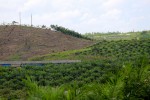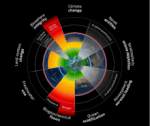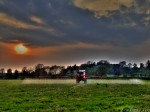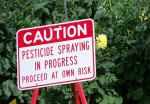News
2015-02-16 | permalink
43.1 million hectares under organic agricultural management worldwide
 Organic farmer in Laos (Photo: Asian Development Bank/flickr)
Organic farmer in Laos (Photo: Asian Development Bank/flickr)
Across the globe, a total of 43.1 million hectares of agricultural land were organic at the end of 2013, with the global market for organic products reaching US$72 billion. This is the result of the latest edition of "The World of Organic Agriculture", which was presented by the International Federation of Organic Agriculture Movements (IFOAM) and the Research Institute of Organic Agriculture (FiBL) at the BIOFACH trade fair last week. Compared to the previous year, organic farmland increased by almost 6 million hectares and 170 countries reported organic farming activities. “We are very pleased to see the recent excellent growth worldwide”, said Markus Arbenz, executive director of IFOAM International. “The positive environmental, social and economic impacts of the sector in the global South and North confirm the sector’s importance as a lighthouse.” The regions with the largest areas of organic agricultural land are Oceania (17.3 million hectares or 40% of total organic area) and Europe (11.5 million hectares, 27% of total). In Latin America, 6.6 million hectares of farmland are organic. Australia is the country with the largest organic agricultural area (17.2 million hectares, with 97% of that area used for grazing), followed by Argentina (3.2 million hectares) and the United States (2.2 million hectares). Two million organic producers were reported in 2013. The countries with the highest number of organic producers were India with 650,000 farmers, Uganda (189,610) and Mexico (169,703). The global market for organic products is booming: Market research company Organic Monitor estimates the global market in 2013 to have reached $72 billion (around 55 billion euros). The United States is the leading market with 24.3 billion euros, followed by Germany (€7.6 billion) and France (€4.4 billion). Official market data was published for the first time for China which has become the fourth biggest organic market worldwide. (ab)
2015-02-09 | permalink
Study: Eating organic food can reduce pesticide exposure
 Pesticide-free produce (Photo: heather_on3/flickr)
Pesticide-free produce (Photo: heather_on3/flickr)
People who eat organic foods may have significantly lower pesticide levels in their bodies than those consuming conventionally grown produce, according to a new study published on Wednesday in the journal Environmental Health Perspectives. The study is among the first to predict a person’s pesticide exposure based on information about their usual diet. The scientists analysed dietary information of nearly 4,500 people from six U.S. cities to determine their exposure to organophosphates (OPs), the most common insecticides used on conventionally grown produce in the United States. The researchers linked the typical intake of certain food items to average pesticide residue levels on those foods as measured by the U.S. Department of Agriculture. They then compared these predictions to pesticide metabolite levels measured in urine samples from a subset of participants. Results showed that among individuals eating similar amounts of fruits and vegetables, those who ‘often or always’ ate organic produce had significantly lower OP pesticide residues in their urine than those who ‘rarely or never’ ate organic. “For most Americans, diet is the primary source of OP pesticide exposure. The study suggests that by eating organically grown versions of those foods highest in pesticide residues, we can make a measurable difference in the levels of pesticides in our bodies”, said Cynthia Curl, an assistant professor at Boise State University, who led the study. Conventionally grown foods typically treated with OP pesticides include nectarines, peaches and broccoli. OP pesticides are linked to a number of negative health effects, especially among agricultural workers who are regularly exposed to the chemicals. “The next step is to use these exposure predictions to examine the relationship between dietary exposure to pesticides and health outcomes, including neurological and cognitive endpoints”, Curl said. For those interested in reducing exposure to pesticides, she recommends opting for organic at least in the case of those fruits and vegetables which the Environmental Working Group ranks in its "Dirty Dozen" list. (ab)
2015-02-02 | permalink
Dedicating land to bioenergy won't curb climate change, new report finds
 Land cleared for oil palms (Photo: Mokhamad/CIFOR)
Land cleared for oil palms (Photo: Mokhamad/CIFOR)
Dedicating crops and land to biofuel production will undermine efforts to combat climate change and feed the planet, according to a new report published Thursday by the U.S.-based think tank World Resources Institute. Firstly, turning plants into liquid fuel or electricity is inefficient. Providing just 10% of global transportation fuel from biofuels in 2050 would require an additional 30% of the total energy in all the crops currently produced, the report found. Meeting 20% of the world’s total energy demand by 2050 with bioenergy would even require humanity to at least double the world’s annual harvest of plant material, including plant residues, grass and timber. Secondly, using land for bioenergy production increases the competition for fertile land, the report found. So-called “second generation” technologies, which use crop residues or other wastes, could also lead to competition since most of these residues are already used for animal feed or needed for soil fertility. Increasing biofuel production at a meaningful scale therefore comes at the cost of growing food, animal feed or storing carbon. Thirdly, biofuels do not cut greenhouse gas emissions as much as previously thought. According to the authors, most calculations claiming that bioenergy reduces greenhouse gas emissions relative to burning fossil fuels do not include the carbon dioxide released when biomass is burned. This is based on the theory that these emissions are matched and implicitly offset by the carbon dioxide absorbed by the plants growing the biomass. However, if those plants were grown anyway, for example for food, simply diverting them to bioenergy does not remove any more carbon from the atmosphere. Emissions even increase if forests are cleared to generate bioenergy or to replace fields that were converted to growing biofuels. The report identifies some forms of bioenergy which do not compete for food or land and could reduce greenhouse gas emissions. Examples include growing winter cover crops for energy, timber processing wastes, landfill methane or wood from agroforestry systems. But their potential to meet a considerable share of human energy needs is limited. (ab)
2015-01-27 | permalink
Paper: Food security and sustainable agriculture in the post-2015 agenda
 A change of course in global agriculture is needed (Photo: CIAT/Flickr.com)
A change of course in global agriculture is needed (Photo: CIAT/Flickr.com)
World food security and the goal of changing course in global agriculture must become top priorities in the post 2015 development agenda. This is the key message of a new discussion paper published by Biovision - Foundation for Ecological Development, in cooperation with various other NGOs and institutions. The document outlines key concerns for the final stage of negotiations on the “Sustainable Development Goals” (SDGs). According to the paper, a world free from poverty, hunger and malnutrition, where the right to adequate food is realised for all people, cannot be achieved without a shift to resilient, diverse and productive agriculture and food systems, which are environmentally, socially, and economically sustainable, with a special emphasis on small-scale food producers and supporting their livelihoods. The organisations welcome the “Synthesis Report” published by UN Secretary-General Ban Ki-Moon in December. However, they criticise that he failed to take up some important issues that are crucial to achieving food security, nutrition and sustainable agriculture and food systems. These issues are: the need to double incomes of small-scale food producers; implement resilient agricultural practices; maintain genetic diversity of farmed animals, as well as seeds and cultivated plants; limit extreme food price volatility; cut food waste and food loss in half, and strive to achieve a land-degradation neutral world. The paper calls on stakeholders to ensure that these issues will be reflected in the post-2015 development agenda. In addition, the organisations warn against re-negotiating the outcome document of the Open Working Group (OWG) on SDGs because its proposed 17 goals and 169 targets were developed through an inclusive process. Finally, the discussion paper outlines effective tools and ways in which a change in agriculture can be achieved and how progress can be measured and monitored. (ab)
2015-01-22 | permalink
Earth has crossed several planetary boundaries, study warns
 Planetary boundaries (Graphic: F. Pharand-Deschênes/Globaïa)
Planetary boundaries (Graphic: F. Pharand-Deschênes/Globaïa)
Human activity has pushed the planet across four out of nine environmental boundaries, according to a new study published in the journal Science. An international team of 18 researchers warns that the planetary boundaries that have been crossed are: climate change, loss of biosphere integrity, land-system change and altered biogeochemical flows (phosphorus and nitrogen cycles). Lead author, Will Steffen from the Stockholm Resilience Centre, said “transgressing a boundary increases the risk that human activities could inadvertently drive the Earth System into a much less hospitable state, damaging efforts to reduce poverty and leading to a deterioration of human wellbeing in many parts of the world, including wealthy countries”. Regarding climate change, the scientists argue that carbon dioxide levels should not exceed 350 parts per million (ppm) in the atmosphere. However, the current level is about 399 ppm, and this is growing by about 3 ppm per year. According to Johan Rockström, who is the director of the Stockholm Resilience Centre, “this boundary is consistent with a stabilisation of global temperatures at about 1.5 degrees above pre-industrial levels”. Biodiversity loss and species extinction are also reaching dangerous levels, with rates of extinctions of animals and plants being 10 to 100 times higher than safe levels. The study defines climate change and loss of species as two “core boundaries”, each of which “has the potential on its own to drive the Earth System into a new state should they be substantially and persistently transgressed”. The researchers also sounded the alarm about deforestation and pollution from nitrogen and phosphorus in fertilisers. On the regional scale, even more boundaries have been crossed, such as freshwater use in the western U.S. and in parts of southern Europe and the Middle East. “Implementing methods to use water more efficiently in agriculture can help sort out this dilemma and at the same time increase global food production”, says Dieter Gerten, another co-author. Although it may seem that the paper paints a gloomy picture, the authors wish to emphasise that the findings provide us with the chance to change course. “The world has a tremendous opportunity this year to address global risks, and do it more equitably. In September, nations will agree the UN’s Sustainable Development Goals. With the right ambition, this could create the conditions for long-term human prosperity within planetary boundaries,” said Rockström. (ab)
2015-01-19 | permalink
‘We are fed up!’: 50,000 march against TTIP and GMOs in Berlin
 50,000 take to Berlin’s streets for a better agricultural policy (Photo: Die Auslöser/Flickr)
50,000 take to Berlin’s streets for a better agricultural policy (Photo: Die Auslöser/Flickr)
On 17th January, almost 50,000 people came together in Germany’s capital to call for a change of course in Europe’s agricultural policy. Farmers, consumers and activists took to the streets of Berlin to protest against factory farming, genetic engineering and the Transatlantic Trade and Investment Partnership (TTIP) agreement between the EU and the United States. The march was organised by a broad alliance of more than 100 farmers’, environmental, animal welfare and development organisations, known as “Wir haben es satt!” (we are fed up). “The EU-USA trade agreement, the TTIP, only serves global corporations, and will take away the means of existence from many farms here and across the world”, rally organiser Jochen Fritz told the media. Equipped with posters and creative costumes, farmers, consumers, beekeepers and activists joined the march that was led by a procession of 80 tractors and ended in front of Angela Merkel’s chancellery. “Eating is political. Every single decision I make about what to buy determines how animals are kept or what is grown in our fields. And I can make sure that I support the farmers and not the big agricultural industry corporations”, Fritz said. Police downplayed the protest, saying 25,000 people joined the peaceful demonstration. Now in its fifth year, the ‘We Are Fed Up!’ march takes place annually during the International Green Week – Europe’s biggest agricultural fair that has just begun in Berlin. (ab)
2015-01-16 | permalink
The U.S. approves Monsanto’s dicamba-tolerant GM soybeans and cotton
 Pesticide spraying (Photo: Will Fuller/Flickr.com)
Pesticide spraying (Photo: Will Fuller/Flickr.com)
Monsanto has received final U.S. approval to introduce soybeans and cotton that have been genetically modified to survive spraying with several herbicides, including dicamba. The U.S. Department of Agriculture’s Animal and Plant Health Inspection Service announced on Thursday that the cotton and soybean plants have been granted “non-regulated” status. This approval follows that of 2,4-D tolerant soybeans and corn, billed as the next generation of herbicide-tolerant crops to tackle glyphosate resistant weeds. The decision was heavily criticised by environmental and consumer groups, saying the use of more herbicides will only increase weed resistance in the long run. Food issue research group U.S. Right to Know Executive Director Gary Ruskin was quoted by Reuters as saying: “This is just the latest in an endless string of favours from our federal government to Monsanto.” According to the Center for Food Safety, a U.S.-based non-profit organisation, the anticipated widespread adoption of these genetically engineered crops would lead to an over 10-fold increase in dicamba use in U.S. agriculture, from 3.8 million lbs. at present to more than 43 million lbs. per year. The organisation says genetic engineering is making American agriculture more chemical-dependent and less sustainable than ever before. Dicamba is a selective herbicide used to kill broad-leaved plants. It has been linked to increased rates of cancer in farmers and birth defects in their male offspring. Monsanto developed the new soybeans and cotton to resist a new herbicide that combines dicamba and glyphosate, which Monsanto is branding as components of the “Roundup Ready Xtend” crop system. “The pesticide treadmill spins on, and that’s great news for Monsanto”, Ruskin told Reuters. The company is still waiting for final approval from the Environmental Protection Agency for the herbicide it designed to be used with the crops, which is currently under consideration. (ab)
2015-01-12 | permalink
Report: TTIP could weaken regulations for toxic pesticides
 TTIP: more toxic pesticides? (Photo: jetsandzeppelins/Flickr)
TTIP: more toxic pesticides? (Photo: jetsandzeppelins/Flickr)
The free trade agreement currently under negotiation between the EU and the U.S. threatens to lower standards of protection from toxic pesticides, according to a new report published last week by the Center for International Environmental Law (CIEL). The study analysed a joint proposal from the American and European pesticide lobby groups CropLife America and European Crop Protection Association. The authors show how the pesticide industry is trying to use the ongoing Trans-Atlantic Trade and Investment Partnership (TTIP) negotiations to reduce environmental standards in favor of looser pesticide regulations. If adopted, the proposal would increase the amount of pesticide residue on food sold to consumers in Europe; allow the use of carcinogens and other substances of high concern; and obstruct efforts to protect bees and other pollinators, the study suggests. “Using words like ‘harmonisation’ and ‘cooperation’ the pesticide industry’s proposal hides its true aim: to weaken, slow or stop efforts to protect people and the planet from exposure to toxic chemicals,” says the report’s co-author Erica Smith. The study contains a list of 82 toxic pesticides, which are currently banned in the EU but allowed to be used in the U.S., including carcinogens, endocrine (or hormone) disruptors, developmental toxins and other extremely hazardous substances. CIEL argues that the TTIP could lead to a reintroduction of these banned pesticides in the EU. In addition, the industry proposal recommends adopting the maximum levels of pesticide residues allowed on food to those permitted in the U.S., which in some cases are hundreds of times higher than those allowed in the EU, the study found. CIEL also warns that the proposal could interfere with current moratoriums by the EU and some U.S. local governments on the use of neonicotinoid pesticides associated with the worldwide decline in bee populations. (ab)
2015-01-09 | permalink
Humans erode soil 100 times faster than nature, new study finds
 Soil erosion (Photo: Olivier Girard, CIFOR/Flickr.com)
Soil erosion (Photo: Olivier Girard, CIFOR/Flickr.com)
Deforestation and intensive agriculture can accelerate erosion so dramatically that in just a few decades as much soil can be lost as would naturally occur over thousands of Deforestation and intensive agriculture can accelerate erosion so dramatically that in just a few decades as much soil can be lost as would naturally occur over thousands of years, according to a new study published online in the February issue of the journal Geology. Scientists from the University of Vermont quantified the rate of erosion for ten large river basins in Southeast U.S.A., collecting sediment samples from the rivers and measuring their beryllium-10 content. The amount of beryllium can reveal rates of erosion in the surrounding landscape. Along the southern Piedmont from Virginia to Alabama, clay soils built up for many millennia. The study suggests that rates of hillslope erosion before European settlement were about an inch (2.5 centimetres) every 2,500 years. Then, in just a few decades of intensive deforestation and cotton and tobacco production, as much soil eroded as would have happened in a pre-human landscape over thousands of years, the scientists found. “Soils fall apart when we remove vegetation and then the land erodes quickly”, says Paul Bierman, a geologist at the University of Vermont and co-author of the study. During the period of peak land disturbance in the late 1800s and early 1900s, rates spiked to an inch every 25 years. “Our study shows exactly how huge an effect European colonisation and agriculture had on the landscape of North America,” says Dylan Rood, a member of the research team. “Humans scraped off the soil more than 100 times faster than other natural processes!” Since the Earth does not create that precious soil for crops fast enough to replenish what the humans removed, it is a trend that is unsustainable if continued, the authors warn. According to the researchers, the results of their study could be used to develop smart environmental policies and regulations that will protect threatened soil and water resources for generations to come. (ab)
2015-01-05 | permalink
U.S. agriculture faces lack of young farmers, loss of local knowledge
 Young farmers wanted (Photo: Robert S. Donovan/Flickr)
Young farmers wanted (Photo: Robert S. Donovan/Flickr)
Across the United States, farmers are getting older and fewer young operators are entering the agricultural workforce than in the past, according to a new study published in the December issue of the journal Rangelands. The authors write that the family farms that once dotted the landscape and employed nearly half the U.S. workforce have been replaced by large, often mechanised, operations that employ just 2% of the country's workforce. As long-time farmers grow older, it is becoming increasingly difficult to pass on the family farm. As a result, the number of farms has dropped 63% since 1900 and farm size has increased by 67%. The researchers looked at demographic trends among farm and ranch operators in Wyoming to see if and how the agricultural community was ageing. Based on their results, they paint a gloomy picture: At the current pace of agricultural ageing, there won’t be any farmers under the age of 35 by 2033. By 2050, the average age will be 60, and 34% of all farm and ranch operators will be of retirement age (65 and older). Even if their children and grandchildren show an interest in agriculture, farmers often cannot afford to keep their land and equipment. In addition, the draw of more profitable enterprises, often in urban areas, is a source of migration away from rural landscapes and farming. According to the authors, the demographic trends in Wyoming mirror those seen across the United States. They conclude that the loss of farmers, ranchers and their land is accompanied by the loss of local wisdom. “Agricultural wisdom, often built over generations, is irreplaceable once lost. Grazing practices finely tailored to the individual pasturelands, knowledge of local disease and pest cycles, water conservation strategies that work in tandem with local flora or geologic features - these are forms of place-based knowledge whose subtleties are carried by local operators and which might begin to fade if professional managers begin to dominate”, the study warns. (ab)

